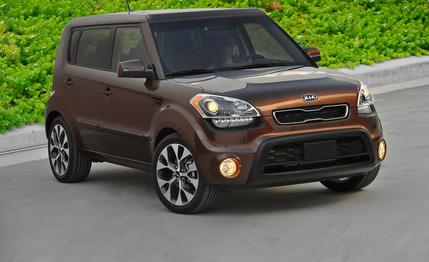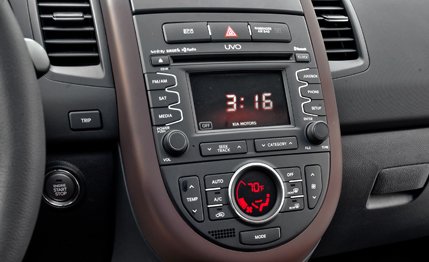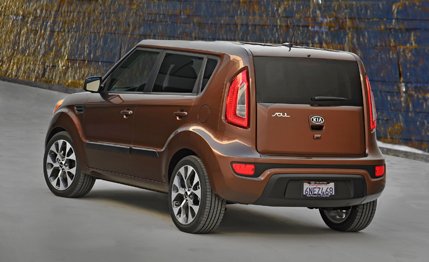
 Instrumented Test
Instrumented Test
What Is It?
When it launched in 2009, the Soul marked Kia’s initial foray into funky design, and the quirky and affordable hatchback has gone on to become one of the Korean automaker’s top sellers, virtually—ahem—boxing out all of its direct competitors. Now 2012 brings the model’s first major revisions, although you’d be hard pressed to identify them without sliding behind the wheel.


The exterior receives only a few mild alterations. The front and rear fascias have been swollen to give the illusion of a wider stance, and new lighting elements have been installed at both ends. Top-tier Exclaim models like our test car (Kia identifies this trim as “!” in its materials) include standard projector headlamps and LED taillights and driving lights, and they get redesigned 18-inch wheels this year.
The interior has been slightly upgraded as well, but again, the changes aren’t readily noticeable to anyone this side of a Soul aficionado or Kia product planner. Still, materials quality is a notch higher, and the center stack has been redesigned for ease of use. (The original interior was filled with hard plastics; its design and graining did well to hide this fact, but we’re nevertheless pleased to see the improvements.) On the Exclaim, a new color screen replaces a dated-looking red-dot-matrix unit, the better to display the feed from the newly standard rearview camera. Also on the Exclaim is an uplevel Infinity audio system with subwoofer and the voice-activated UVO infotainment system. Navigation is available with the Premium package, but it cannot be paired with UVO. Finally, yes, the multicolored, dancing speaker lights carry over.


How Does It Drive?
Even though the competent chassis is basically unchanged—it still offers accurate and obedient steering, eager turn-in, and well-controlled body motions—the Soul drives much better than before, largely on the back of the upgraded engine and transmission. New this year are six-speed manual and automatic transmissions, which replace five- and four-speed units, respectively. The 2.0-liter four-cylinder, standard in the Exclaim and mid-level Plus, gains 22 hp and 11 lb-ft of torque for totals of 164 hp and 148 lb-ft. (The base Soul’s 1.6-liter four adds direct injection for a small power boost, too.) Nevertheless, fuel-economy ratings for the 2.0-liter are bumped to 26 mpg city and 34 highway; last year, it achieved 24/30. Our penchant for pinning the accelerator to the floor netted 21 mpg overall. (Mileage hounds would be advised to wait for the Soul Eco model, which arrives later this year with an engine stop/start system, low-rolling-resistance tires, and a button to reduce throttle sensitivity; it is expected to achieve 29/36 mpg with the 1.6 and 27/35 with the 2.0.)
The new powertrain greatly improves the Soul’s everyday drivability, especially in the automatic-only Exclaim, where passing maneuvers can now be executed with much more confidence. Zero to 60 mph takes 8.2 seconds, and the quarter-mile is reached in 16.4 seconds at 84 mph. Neither is a blistering figure, but they’re on par with those of the old 2.0 when paired with the five-speed manual. (That car turned in times of 7.9 and an equal 16.4 seconds; we didn’t test the previous engine with the four-speed auto.) The six-speed automatic shifts smoothly, and our only real complaint was its willingness to allow a cold engine to briefly bang the rev limiter in first gear before selecting second.
Braking performance was very consistent in our testing, and the Soul turned in a 167-foot 70-to-0-mph stop, right about average for the segment. Average also describes the stability-control-inhibited 0.80 g recorded on the skidpad.


Another great stride: significantly reduced NVH. Thicker insulation for the dash, A-pillars, and floor, along with better door seals and an exhaust silencer, make a huge difference, bringing some solitude to the experience. Exclaim models have additional subframe and engine-mount dampening, too. Even with the 18-inch wheels, there’s less road and suspension noise—an observation objectively backed by a 70-mph cruising sound level that is 5 dB lower than before.
How Does It Stack Up?
Boxes are good for stacking, and the Soul really towers over its competition. With the Honda Element now dead and gone, the Scion xB and the Nissan Cube are the only squares left to duke it out with the Soul, and the Kia is a much better drive than either. It also acquits itself well against more conventionally styled hatches. With a low price of entry, a spacious interior, and agreeable dynamics, Kia’s box has been an enticing option from the git-go, but the 2012 model largely rights its few wrongs. If sales numbers are to judge the score of this fight, the Soul is the undisputed champ. In November 2011, Kia moved nearly 7000 Souls, about five times the number of Cubes and xBs combined.
What’s the Cost?
Not much for what you get, really. A base Soul is $14,650, and a minimum of $17,050 is required to get the 2.0-liter engine (in the manual Soul Plus). The top-level Exclaim model costs $20,350, which was the as-tested price for our options-free test car. Besides the aforementioned exterior bits and Infinity stereo, the Exclaim brings a sunroof, a leather-wrapped tilting-and-telescoping steering wheel, USB and aux inputs, and keyless entry. A $2500 Premium package adds navigation, leather seats (heated for front occupants), pushbutton start, and automatic climate control. Although we have a deep affection for warm seats on a cold winter’s day, we’d skip the Premium pack and use some of the savings to pick up some snow pants and an aftermarket nav unit.
With its unique styling and well-appointed and flexible interior—all at a bargain price—it’s no wonder the Soul has been such a success for Kia. And now that its few drawbacks have been addressed, any small-car shopper should check out the Soul.